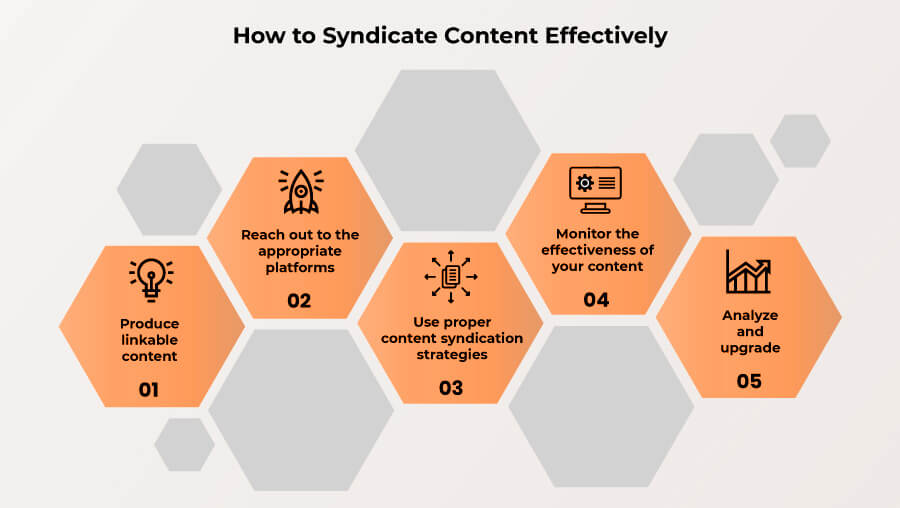
Modern growth marketing relies heavily on content syndication. It’s always been like this way. However, content syndication strategies and the mastrateterial types that power it have evolved over time.
Previously, blog entries were the only type of information that could be syndicated. But have you ever wondered, “how does content syndication work?” Other forms of information, however, are increasingly published as well. Syndication is still crucial, despite the fact that SEO has advanced over time.
What exactly is content syndication, though? What does it mean for your SEO? What are the advantages and disadvantages? And how do you successfully syndicate content? These are some pressing concerns you may have. This blog will cover all of these topics and more.
How Does Content Syndication Work? Generate Leads & Boost Reach
What Is The Definition Of Content Syndication?
The practice of releasing your online material on a third-party platforms is known as content syndication.
The main goal of content syndication is to attract a bigger population via a third-party website and then route that traffic to your own. It may also be utilized as part of a growth hacking plan to reach out to a larger audience and raise brand recognition.
So, how exactly does content syndication work?
To begin, you must have a robust content syndication plan in place. Content syndication may be done in a variety of ways, including:
- Republishing the exact and every piece of content
- Editing the content elements in order to produce a condensed version
- Posting a portion of or a synopsis of the original work
Why Should You Syndicate Content?
It’s possible to think of content syndication as a bargaining system. For its audience, the third-party platform receives useful, free material. At the same time, the author of the content is exposed to a larger audience.
This trade mechanism, however, is not new. Well before digitalization became fashionable, major news organizations carried syndicated material from freelancers and smaller media on their websites. Content syndication allowed freelancers and smaller media to be recognized for their work while allowing larger outlets to avoid investing in the resources needed to generate content.
But, after all, why do businesses now utilize content syndication?
The author and content producer do it for a number of reasons, including increasing website traffic, generating leads, and building backlinks, among others.
The Advantages Of Content Syndication

1. Exposure To The Content
Content syndication allows you to reach out to prospects, viewers, andf readers who would not have otherwise came across your brand by using paid or free content syndication.
A simple infographic on an authoritative platform may get your information thousands of more views than simply putting it on your own site. You may also syndicate pieces on that site on a regular basis to attract new visitors to your material.
Overall, content syndication improves the exposure of material you’ve paid for or spent a significant amount of time generating.
Articles (or portions from them), eBooks, whitepapers, videos (there are platforms for syndicating video content), and other types of syndicated material are all options. Syndication helps you develop your reputation as a thought expert by allowing you to reach more of your company’s clients through content delivery marketing.
Content syndication increases traffic while also allowing more people to follow your identity and content. As a result, your website, social media accounts, and other platforms can reach a larger audience.
2. Lead Generation
The use of content syndication for lead generation to establish inbtellectual dominance is a quick and efficient method.
Each bit of content that syndicates restricted material can generate actual cash. Before obtaining their content materials, prospects must fill in their contact information.
This syndication-based B2B lead generation technique allows you to acquire the prospect’s data, which you can then utilize to engage them and persuade them into customers.
It’s crucial to consider three things while monitoring the leads you’ve gotten from syndicated content:
- When people sign up for eBooks, webinars, or similar sorts of material, they’re more intrigued in the subject than in your service.
- This customer may not be connected with your brand or service since they have not accessed material from your website.
- It’s critical to adhere with your leads promptly, even though if you wait too long, they may forget about your company. Everything revolves around timing. Read this insightful article about content syndication metrics.
3. Link Generation
Content syndication websites may publish your content, including articles, films, and graphics, and credit you by linking back to it.
This aids in the enhancement of your website’s SEO, which in turn aids in the enhancement of your SERP ranks (Search Engine Results Pages). As a result, the authority of your brand will rise on the internet.
Furthermore, the better rating and syndicated postings may result in increased traffic to your website. This not only helps you improve your SEO, but it may also help you increase your revenue and sales.
Content syndication is another successful technique to reach a larger audience, although it does come with certain hazards. Repeated material is frowned upon by search engines.
As a result, if a search engine discovers many pages with the same information, only one of them will appear on the search result. This is why it’s critical to include a link to the original source in every syndicated content. These links inform the search engine that the article they’re swarming is syndicated.
How To Syndicate Content Effectively?
While content syndication may appear to be a dream come true for any content marketer, it’s critical that you do it correctly.
This because? Syndicated material, as we’ve seen, might be mistaken for duplicate content if done incorrectly. This can harm your internet reputation, have an influence on your SEO, and a lot more.
Let’s look at some procedures you may do to properly syndicate material to avoid such problems.

- Produce linkable content
- Reach out to the appropriate platform
- Use proper content syndication strategies
- Monitor the effectiveness of your content
- Analyze and upgrade
Must Read: Content syndication networks that will drive traffic
Conclusion:
As a result, make certain that your online material is syndicated on the appropriate websites and in the appropriate manner. If you don’t, you won’t be able to take advantage of the many benefits of content syndication, and you may end up losing more money than you gain.
You’ve got the content syndication tools, the data, and the advice you need to get started with this blog. So go ahead and syndicate your material to expand your business and scale up your content marketing plan. And if you need any assistance, simply get in touch with us and we will be very happy to oblige.


Vikas Bhatt is the Co-Founder of ONLY B2B, a premium B2B lead generation company that specializes in helping businesses achieve their growth objectives through targeted marketing & sales campaigns. With 10+ years of experience in the industry, Vikas has a deep understanding of the challenges faced by businesses today and has developed a unique approach to lead generation that has helped clients across a range of industries around the globe. As a thought leader in the B2B marketing community, ONLY B2B specializes in demand generation, content syndication, database services and more.

.webp)
